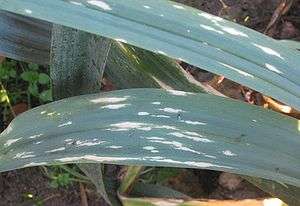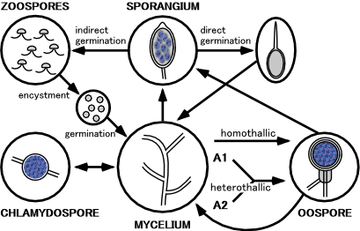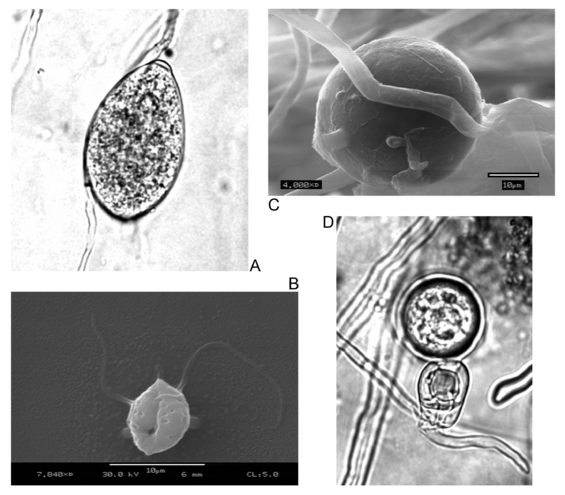| Phytpothora | |
|---|---|
 | |
| Type: | Water mold (Oomycete) |
| Genus: | Phytophthora |
| Conditions: | Favored by wet soils |
| Transmission: | zoospores, tools, etc. |
Phytophthora (from Greek phytón, “plant” and phthorá, “destruction”, “plant-destroyer”) is a genus of plant-damaging Protists of the Oomycetes (water moulds). Heinrich Anton de Bary described it for the first time in 1875.
Phytophthora is sometimes referred to as a fungus-like organism but it is classified under a different kingdom altogether: Stramenopila (previously named Chromista). In contrast to Fungi, stramenopiles are more closely related to plants than animals. Whereas Fungal cell walls are made primarily of chitin, stramenopile cell walls are constructed mostly of cellulose.
Phytophthoras reproduce both sexually and asexually. Sporangia, zoospores, and chlamydospores are asexual. Oospores are sexual.
Symptoms and Signs
Infection by Phytophthora leads to root rots, cankers, foliar blights, and usually results in the death of the host plant. Symptoms vary according to both the pathogen species and the host species.
Life Cycle
Phytophthora can live for long periods in the soil without the presence of a host. During wet contitions, the zoospores swim towards host plants following chemical traces. Once a plant is infected, it cannot be "cured", but may be sustained through foliar feeding for a time, depending on the host's natural resistance.

Host Range
Phytophthoras are mostly pathogens of dicotyledons, and are relatively host specific parasites. Many species of Phytophthora are plant pathogens of considerable economic importance. Phytophthora infestans was the infective agent of the potato blight that caused the Irish potato famine. Research beginning in the 1990s has placed some of the responsibility for European forest die-back on the activity of imported Asian Phytophthoras[1].
Species and host genera
- Phytophthora alni – causes alder root rot
- Phytophthora arecae
- Phytophthora botryosa
- Phytophthora cactorum – causes rhododendron root rot affecting rhododendrons, azaleas and causes bleeding canker in hardwood trees
- Phytophthora cajani
- Phytophthora cambivora
- Phytophthora capsici - Leaf spot, damping-off, fruit rots, stem rots, and wilts of Pepper, Tomato, and Eggplant, though the host range has been found to be much wider.[2][3][4]
- Phytophthora cinnamomi - causes cinnamon root rot affecting woody ornamentals including arborvitae, azalea, Chamaecyparis, dogwood, forsythia, Fraser fir, hemlock, Japanese holly, juniper, Pieris, rhododendron, Taxus, white pine and American Chestnut
- Phytophthora citricola
- Phytophthora citrophthora
- Phytophthora clandestina
- Phytophthora colocasiae
- Phytophthora cryptogea
- Phytophthora drechslera
- Phytophthora erythroseptica
- Phytophthora fragariae - causes red root rot affecting strawberries
- Phytophthora gonapodyides
- Phytophthora heveae
- Phytophthora humicola
- Phytophthora idaei
- Phytophthora ilicis
- Phytophthora infestans
- Phytophthora inflata
- Phytophthora iranica
- Phytophthora katsurae
- Phytophthora lateralis
- Phytophthora medicagnis
- Phytophthora megakarya
- Phytophthora megasperma
- Phytophthora melonis
- Phytophthora mirabilis
- Phytophthora multivesiculata
- Phytophthora nicotianae
- Phytophthora palmivora - causes fruit rot in coconuts and betel nuts
- Phytophthora phaseoli
- Phytophthora porri
- Phytophthora primulae
- Phytophthora pseudotsugae
- Phytophthora quercina – causes oak death
- Phytophthora ramorum – infects over 40 plant genera and over 100 host species - causes Sudden Oak Death[5]
- Phytophthora sinensis
- Phytophthora sojae - causes soybean root rot
- Phytophthora syringae
- Phytophthora tentaculata
- Phytophthora trifolii
- Phytophthora vignae
Controls
Plant diseases caused by this genus are difficult to control chemically, thus resistant cultivars are grown as a management strategy.
- Cultivation: Some bacteria and fungi associated with composts can suppress the activity of soil-borne phytophthora.
- Cultural Controls: Raised beds and other techniques to improve drainage
- Disposal: Infected materials should not be composted
References
- ↑ "Phytophthora: Asiatischer Pilz lässt die Bäume sterben" Süddeutschen Zeitung 11 May 2005
- ↑ Hawaii Extension Service
- ↑ Florida Extension Service
- ↑ APSnet
- ↑ "APHIS List of Regulated Hosts and Plants Associated with Phytophthora ramorum" U.S. Animal and Plant Health Inspection Services;
- Lucas, J.A. et al. (eds.) (1991) Phytophthora based on a symposium held at Trinity College, Dublin, Ireland September 1989. British Mycological Society, Cambridge University Press, Cambridge, UK, ISBN 0-521-40080-5 ;
- Erwin, Donald C. and Ribeiro, Olaf K. (1966) Phytophthora Diseases Worldwide American Phytopathological Society Press, St. Paul, Minnesota, ISBN 0-89054-212-0
- Erwin, Donald C. (1983) Phytophthora: its biology, taxonomy, ecology, and pathology American Phytopathological Society Press, St. Paul, Minnesota, ISBN 0-89054-050-0
- "APHIS List of Regulated Hosts and Plants Associated with Phytophthora ramorum" U.S. Animal and Plant Health Inspection Services
- Goodwin, Stephen B. (January 2001) "Phytophthora Bibliography" Purdue University;
- Abbey, Tim (2005) "Phytophthora Dieback and Root Rot" College of Agriculture and Natural Resources, University of Connecticut;
